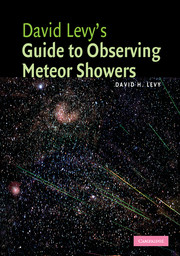Book contents
- Frontmatter
- Contents
- Preface
- 1 July 4, 1956
- 2 What is a meteor?
- 3 Some historical notes
- 4 Small rocks and dust in space
- 5 Observing meteors
- 6 Recording meteors
- 7 A New Year gift: the Quadrantids
- 8 The Lyrids – an April shower
- 9 The Eta Aquarids
- 10 The Omicron Draconids, continued
- 11 The Delta Aquarids
- 12 Tears of St. Lawrence: Perseid trails and trials
- 13 The August Pavonids
- 14 The Orionids
- 15 The Taurids
- 16 The Leonids
- 17 The Geminids
- 18 The Ursids
- 19 A catalog of meteor showers throughout the year
- Appendix
- Index
4 - Small rocks and dust in space
Published online by Cambridge University Press: 06 July 2010
- Frontmatter
- Contents
- Preface
- 1 July 4, 1956
- 2 What is a meteor?
- 3 Some historical notes
- 4 Small rocks and dust in space
- 5 Observing meteors
- 6 Recording meteors
- 7 A New Year gift: the Quadrantids
- 8 The Lyrids – an April shower
- 9 The Eta Aquarids
- 10 The Omicron Draconids, continued
- 11 The Delta Aquarids
- 12 Tears of St. Lawrence: Perseid trails and trials
- 13 The August Pavonids
- 14 The Orionids
- 15 The Taurids
- 16 The Leonids
- 17 The Geminids
- 18 The Ursids
- 19 A catalog of meteor showers throughout the year
- Appendix
- Index
Summary
Captain: 'Tis thought the king is dead; we will not stay.
The bay-trees in our country are all wither'd
And meteors fright the fixed stars of heaven;
The pale-faced moon looks bloody on the earth
And lean-look'd prophets whisper fearful change …
Isn't it strange that of all the many pieces of our Solar System, it is the smallest ones – comets, meteors, and an eclipse of the Moon, that attracted the attention of civilizations right up to Shakespeare's time 400 years ago? While the great worlds orbit the Sun, their motions are predictable and are not a cause for alarm. But a meteor shower did attract notice, along with an increasing interest in the workings of our Solar System. Our solar neighborhood is a big place, with several different types of object in its domain, ranging in size from one star, the Sun, to tiny micrometeoroids that are even smaller than the meteors this book is about. These objects include the Sun, planets, moons, comets, asteroids, meteoroids, and micrometeoroids. It seems a simple division, but recent debates tell us that the boundaries among these types of objects are fuzzy at best. See Figure 4.1.
Categorizing objects in our Solar System
The best known debate concerns the definition of a planet. In 2006 the International Astronomical Union defined a planet in a most controversial way.
- Type
- Chapter
- Information
- David Levy's Guide to Observing Meteor Showers , pp. 18 - 26Publisher: Cambridge University PressPrint publication year: 2007



